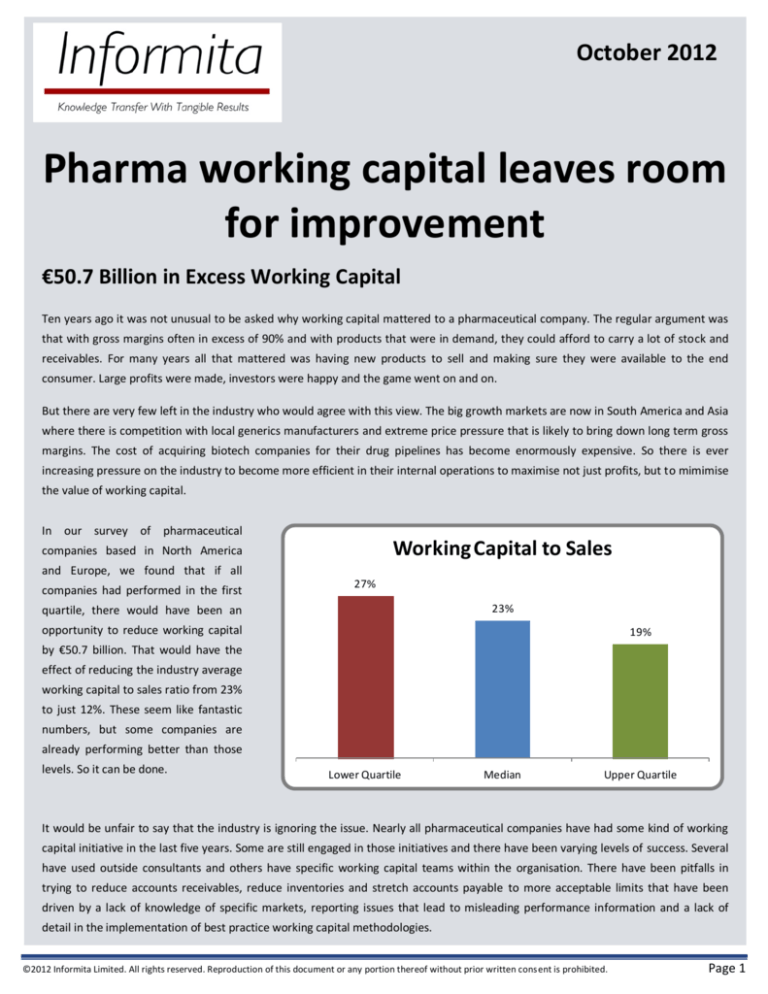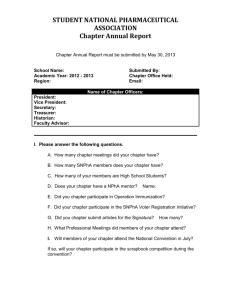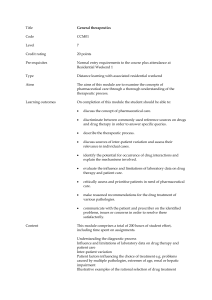
October 2012
Pharma working capital leaves room
for improvement
€50.7 Billion in Excess Working Capital
Ten years ago it was not unusual to be asked why working capital mattered to a pharmaceutical company. The regular argument was
that with gross margins often in excess of 90% and with products that were in demand, they could afford to carry a lot of stock and
receivables. For many years all that mattered was having new products to sell and making sure they were available to the end
consumer. Large profits were made, investors were happy and the game went on and on.
But there are very few left in the industry who would agree with this view. The big growth markets are now in South America and Asia
where there is competition with local generics manufacturers and extreme price pressure that is likely to bring down long term gross
margins. The cost of acquiring biotech companies for their drug pipelines has become enormously expensive. So there is ever
increasing pressure on the industry to become more efficient in their internal operations to maximise not just profits, but to mimimise
the value of working capital.
In our survey of pharmaceutical
Working Capital to Sales
companies based in North America
and Europe, we found that if all
companies had performed in the first
27%
23%
quartile, there would have been an
opportunity to reduce working capital
19%
by €50.7 billion. That would have the
effect of reducing the industry average
working capital to sales ratio from 23%
to just 12%. These seem like fantastic
numbers, but some companies are
already performing better than those
levels. So it can be done.
Lower Quartile
Median
Upper Quartile
It would be unfair to say that the industry is ignoring the issue. Nearly all pharmaceutical companies have had some kind of working
capital initiative in the last five years. Some are still engaged in those initiatives and there have been varying levels of success. Several
have used outside consultants and others have specific working capital teams within the organisation. There have been pitfalls in
trying to reduce accounts receivables, reduce inventories and stretch accounts payable to more acceptable limits that have been
driven by a lack of knowledge of specific markets, reporting issues that lead to misleading performance information and a lack of
detail in the implementation of best practice working capital methodologies.
©2012 Informita Limited. All rights reserved. Reproduction of this document or any portion thereof without prior written consent is prohibited.
Page 1
Receivables: Improved but obstacles remain
For many this has been the area to begin improving, but sometimes the picture wasn’t that bad to start. For example, if your largest
market is the United States it is likely that you deal through the three big distributors. If that is that case you will probably have DSO’s
(Days Sales Outstanding) in the low 30’s and your big issue is not getting paid but dealing with the huge volume of deductions that
inevitably happen when you are in the US pharmaceutical market. Equally, if your key markets are Northern and Western Europe, it is
very likely that you get paid fairly quickly. The only real exception to this would be German pharmacies where you are legally obliged
to supply even if you don’t get paid.
What drives up the DSO number are
Days Sales Outstanding
three broad factors: Southern Europe,
Eastern Europe and emerging markets
79 Days
such as Brazil, India and China.
67 Days
58 Days
In Southern Europe, the fate of
pharmaceutical companies is very
much tied to the fiscal health of the
governments of these countries. The
write-down of the value of Greek
government bonds has already hurt
many. Portugal will gradually improve
as IMF/EU monies trickle through the
Lower Quartile
Median
Upper Quartile
system. Spanish issues are closely
aligned to the indebtedness of the
regions
regions. In Italy, the continuing chaos in public healthcare finance continues but some companies were fortunate enough to have
factored all or some of their Italian receivables in recent years.
Eastern Europe has been a longer running problem usually with two core issues. The first is working with distributors who don’t pay
you until they are paid. The usual way to get at the front of the payment queue is to pay generous commissions. Otherwise expect
DSO’s in the several hundreds. The other issue has been the legacy of underfunded healthcare systems. Not only has this put pressure
on the receivables numbers, but the risk of default is very high.
The emerging economies have been the growth markets of recent years and that trend is likely to continue. But there is more
competition from local manufacturers, patent infringement in countries such as India and these countries tend to have much longer
payment terms than the old core markets in Europe and North America.
Because of all these circumstances, it is more necessary than ever to have solid accounts receivable processes that do a few things
very well. The first is having a proper understanding of the market. In each case, behaviour will be driven by the specific market. No
two markets will operate in the same way and they must be understood. This is particularly important when assessing customer risk.
The second piece is making sure that there is an effective collections process in place in each market. That doesn’t necessarily mean
the same process for each market since what is defined as the customer can be very different country by country. This is often the
most difficult area in which to succeed. It is common that the local market organisation will strongly resist direct customer contact
from collectors. This is likely to be perceived as a threat to revenues. That is why the third component must be incentivisation of sales
people in the market. Without incentives it is very difficult for many non-financial people to properly understand the importance of
collecting customer debts on time.
©2012 Informita Limited. All rights reserved. Reproduction of this document or any portion thereof without prior written consent is prohibited.
Page 2
Payables: Patchy progress
Supplier payment terms are always a sensitive subject for pharmaceutical companies. The risk of looking like a bully to smaller
suppliers is always to be avoided. There is broad agreement across the industry that suppliers should be treated fairly. There is also a
problem with how accounts payable balances are reported that can create large distortions. This mainly affects those companies that
do a large part of their business in the United States and make promotional payments to doctors. Because of different accounting
methodologies, some company’s accounts payable balances can seem much higher than they ordinarily would and means that
comparing specific company’s performances in this area is meaningless unless the specific accounting treatments are fully
understood.
But even taking account of this known potential distortion there are massive disparities across the globe with both the shortest and
longest DPO (Days Payable Outstanding) awards going to US based firms. Even if the extremes of the US based firms are excluded, the
average DPO for the remainder is still 117 days, with a low of 37 days and a high of 219 days. That would suggest that some
companies still have considerable scope to increase their DPO.
Some firms have already made great strides in moving supplier payment terms and along the way the have uncovered several basic
issues that needed to be overcome before serious progress could be made. One of the first issues is to obtain accurate transactional
data on a global scale that will tell who are all their suppliers, what are their payment terms and if they are paid on time. This might
seem
seem like a simple exercise, but it is not
for the faint hearted. Most major
Days Payable Outstanding
pharmaceutical companies operate in
excess of 100 territories and very few
136 Days
have a single global ERP instance. Once
the data is obtained, it can be very
98 Days
revealing. One company discovered that
their major business services supplier
74 Days
operated on 29 different payment terms
even though a global contract was in
place. At another, it was discovered that
suppliers were being paid early on a
routine basis and that this had cancelled
Lower Quartile
Median
Upper Quartile
out the expected benefit of stretching
contractual payment terms.
The next thing is to understand your limits. Some countries have legislation limiting payment terms in specific instances. There are set
norms in different parts of the world that need to be understood. There are those suppliers that are deemed sensitive from either a
commercial or publicity perspective. Understanding all these elements in detail will allow your company to set realistic payment term
targets to be implemented by the joint forces of procurement and accounts payable pulling together.
Once the targets are in place and the action plan for change is agreed, it will be necessary to go back to the data and set up detailed
transactional monitoring. This will ensure that there is full visibility of supplier activity that will make certain that supplier terms are
changed to the agreed target terms within the agreed timescale. But be ready for bumps in the road. Some suppliers will refuse to
accept the new payment terms. Negotiation might be necessary and persistence will be a must. And that same reporting must
become a permanent fixture so that the gains achieved do not slide in the following years. Accounts payable might seem like the poor
relation in working capital terms, but there are lucrative opportunities to reduce working capital for those who are properly prepared
for the journey.
©2012 Informita Limited. All rights reserved. Reproduction of this document or any portion thereof without prior written consent is prohibited.
Page 3
Inventories: A difficult opportunity
By any standards the level of inventories held by most pharmaceutical companies would make most CFO’s eyes water. But there are
good historical reasons for these high levels of inventories.
The very first is that all pharmaceutical companies are brutally aware that patients could die if they don’t receive their medications on
a timely basis. This is less of a concern where alternatives are available, but there are still many medicines where no alternative is
available.
The second reason is one that has largely been created by the industry itself, namely extremely centralised manufacturing. In the
constant
constant
Days Inventory Outstanding
pursuit
of
manufacturing
efficiency and maximised profits, there
has been a tendency over many decades
to centralise manufacturing across the
195 Days
industry to produce the largest batch
size possible and the lowest unit cost.
148 Days
119 Days
This has had the desired effect on the
profit and loss side of the equation, but
has
meant
that
inventories
have
ballooned as the reach of the global
supply chain has increased. On top of
this, the usual part of the organisation
Lower Quartile
Median
Upper Quartile
to end up with the expensive finished
goods
inventory
is
the
market
organisation and not manufacturing.
Equally, of the larger market organisations this presents little problem since batch sizes are often optimised for these larger affiliates.
But for smaller affiliates it means holding large amounts of stock that they don’t need but are forced to hold.
It would be very simple to make smaller batches, but this would create other logistical problems and impact on margins. In many cases
the trade-off between inventory holding and margins is unknown. This sounds astonishing but is often true. And even if these tradeoffs were known, the implementation of a more flexible manufacturing model would likely require a complete re-design of the entire
supply chain.
For this reason it is common that most pharmaceutical organisations start with simpler initiatives like reducing raw materials or
packaging inventories. These areas will provide quicker wins, but the value impact compared to finished goods stock reductions will be
relatively modest.
The requirement to run a flexible manufacturing model isn’t going to go away and might take several years to achieve, but the goal
must be the creation of a manufacturing model that is responsive to real customer demand and is flexible enough to respond to
changing market conditions. To someone outside the pharmaceutical industry this will sound like the basics, but they have forgotten
that general industry has learned these lessons and implemented solutions to optimise inventories over many decades. Most
pharmaceutical companies now have to do a lot of catching up to attain the level of working capital efficiency that exists in other
industries, but this is the only path to improvement. The key in the coming years will be to set the right levels of expectation for
change. You cannot change cultures that have been focused on unit cost reduction for decades in a short period of time. People will
require education in new concepts and time to understand their full implications.
©2012 Informita Limited. All rights reserved. Reproduction of this document or any portion thereof without prior written consent is prohibited.
Page 4
Conclusion: The prize is large, but the road may be rocky
We don’t know of any pharmaceutical company that is not taking working capital seriously and most people recognise that there is an
awful lot to be done on all fronts. The biggest issue in the past was overcoming corporate cultures that could not understand why such
hugely profitable companies would worry about working capital. But increasingly it is becoming an operational necessity. Several firms
have already made a lot of progress, but almost no-one considers that the full prize has been grasped.
Survey Methodology
Informita has compiled information from the following companies published accounts for the year ended 2011:
Abbott Laboratories, Actelion Ltd., Allergan Inc., Amgen Inc., AstraZeneca PLC, Bayer AG, Biogen Idec Inc., Boiron SA, Bristol-Myers
Squibb Company, Celgene Corporation, Eli Lilly & Co., Endo Pharmaceuticals Holdings Inc., Forest Laboratories Inc., Galenica Ltd.,
Gilead Sciences Inc., GlaxoSmithKline plc, Grifols, S.A., H. Lundbeck A/S, Hospira Inc., Ipsen S.A., Johnson & Johnson, Laboratorios
Almirall SA, Meda AB, Merck & Co. Inc., Merck KGaA, Novartis AG, Novo Nordisk A/S, Orion Corporation, Perrigo Co., Pfizer Inc.,
Recordati SpA, Roche Holding AG, Sanofi, Shire plc, Stada-Arzneimittel AG, UCB SA, Warner Chilcott plc, Watson Pharmaceuticals, Inc.
The measurements utilised have been calculated according the following methods:
Net Working Capital to Sales Ratio - Revenue / Working Capital * 100;
Days Sales Outstanding – Trade Accounts Receivables / Revenue * 365;
Days Payable Outstanding – Trade Accounts Payable / Cost of Goods Sold * 365; and,
Days Inventory Outstanding – Total Inventory / Cost of Goods Sold * 365.
About Informita
Informita was formed to act as an advisor to companies in the areas of working capital and procurement, focusing on Analytics,
Implementation and Advisory. Informita is there to support your working capital and procurement programmes from cradle to grave
in a cost efficient and effective manner. Our people have a mixture of deep industry and consulting experience across many sectors
and geographies. This gives us the ability to bring insights across many industries and cultures.
Website: www.informita.com
Twitter:
@informita
Email: info@informita.com
Phone:
©2012 Informita Limited. All rights reserved. Reproduction of this document or any portion thereof without prior written consent is prohibited.
+44-20-3286-4109
+44-7769-260-042
Page 5








